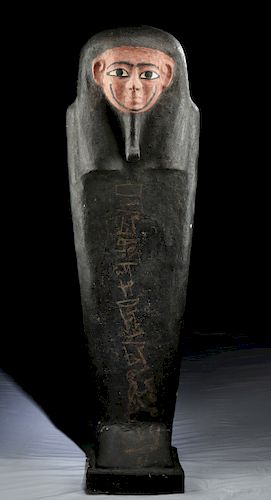Egyptian Cedar / Painted Gesso Coffin for Iret Horru
Lot 16a
About Seller
Artemis Gallery
686 S Taylor Ave, Ste 106
Louisville, CO 80027
United States
Selling antiquities, ancient and ethnographic art online since 1993, Artemis Gallery specializes in Classical Antiquities (Egyptian, Greek, Roman, Near Eastern), Asian, Pre-Columbian, African / Tribal / Oceanographic art. Our extensive inventory includes pottery, stone, metal, wood, glass and textil...Read more
Estimate:
$60,000 - $90,000
Absentee vs Live bid
Two ways to bid:
- Leave a max absentee bid and the platform will bid on your behalf up to your maximum bid during the live auction.
- Bid live during the auction and your bids will be submitted real-time to the auctioneer.
Bid Increments
| Price | Bid Increment |
|---|---|
| $0 | $25 |
| $300 | $50 |
| $1,000 | $100 |
| $2,000 | $250 |
| $5,000 | $500 |
| $10,000 | $1,000 |
| $20,000 | $2,500 |
| $50,000 | $5,000 |
| $100,000 | $10,000 |
| $200,000 | $20,000 |
About Auction
By Artemis Gallery
Sep 26, 2019
Set Reminder
2019-09-26 10:00:00
2019-09-26 10:00:00
America/New_York
Bidsquare
Bidsquare : Exceptional Day 1: Antiquities & Asian Art
https://www.bidsquare.com/auctions/artemis-gallery/exceptional-day-1-antiquities-asian-art-4437
Day 1 of an important 2-day auction featuring exceptional, museum-worthy examples of Egyptian, Greek, Etruscan, Roman, Viking, Russian, Near Eastern, as well as Asian Art from China, Japan, Thailand, Vietnam, Burma and India. Artemis Gallery info@artemisgallery.com
Day 1 of an important 2-day auction featuring exceptional, museum-worthy examples of Egyptian, Greek, Etruscan, Roman, Viking, Russian, Near Eastern, as well as Asian Art from China, Japan, Thailand, Vietnam, Burma and India. Artemis Gallery info@artemisgallery.com
- Lot Description
Egypt, Late Dynastic Period, 26th Dynasty, Saite Period, ca. 664 to 525 BCE. A stunning inner coffin, carved from finely grained cedar, with an anthropoid lid secured to the mortises of the lower body via several tab-form tenons. A thin layer of white gesso creates the ground for matte black pigment - typically reserved for high-class individuals - as well as a column of yellow hieroglyphic inscription. The characteristically oversized face features a russet-red base color as well as elongated eyes outlined in black, a bulbous nose, thin lips with a delineated philtrum, tall ears, and a black chin strap above a false beard with a rounded lower tip, all beneath a puffy tripartite wig. The hieroglyphic inscription on the front identifies this coffin for Iret-Horru (also Iret-Horrou, Irethorrou), a wealthy priest of Min from the economically thriving city of Akhmim and a prophet of the funerary deity Osiris-Sokar. Size: 19" W x 69.25" H (48.3 cm x 175.9 cm).
Anthropoid coffins like this example first appeared by the Middle Kingdom - skillfully carved so as to outline the mummy's body and decorated with the visage and wig of the deceased individual. Such coffins not only served to copy the mummy's form kept within, but also served as actual substitutes for the bodies in the event that the mummy's body was lost or destroyed. As time progressed, these coffins were decorated with more extensive iconographic programs, presenting a greater number of inscriptions.
This sarcophagus and others like it were traditionally carved from cedar, though cedar was only used by those wealthy families who could afford the exotic hardwood. Interestingly, cedar wood was not native to Egypt. Egypt did not have verdant forests filled with tall trees, and unfortunately most of its native lumber was of relatively poor quality. Thus, they relied on importing to acquire hardwoods - ebony imported from Africa, cedar and pine from Lebanon. One fabulous obelisk inscription by Thutmose III attests to the luxury of treasured hardwoods. It reads as follows, "They brought to me the choicest products . . . consisting of cedar, juniper and of meru wood . . . all the good sweet woods of God's Land." The rarity of cedar meant that coffins like this one were reserved for those who could afford them.
For an example of a strikingly similar coffin carved from limestone, please see: Ikram, Salima and Aidan Dodson. "The Mummy in Ancient Egypt: Equipping the Dead for Eternity." Thames and Hudson, London, 1998, p. 242, fig. 328.
For a greywacke statue of Iret-Horru standing with Osiris, please see The Walters Art Museum, accession number 22.215.
For images of the outer coffin as well as a detailed article on Iret-Horru by curator Dr. Renee Dreyfus and Egyptologist Jonathan P. Elias of the Fine Arts Museum of San Francisco, please see "Mummy by the Bay: Irethorrou, an Egyptian Priest of the Early Persian Period."
Provenance: private J.H. collection, Beaverton, Oregon, USA; ex-private Beverly Hills, California, USA collection
All items legal to buy/sell under U.S. Statute covering cultural patrimony Code 2600, CHAPTER 14, and are guaranteed to be as described or your money back.
A Certificate of Authenticity will accompany all winning bids.
We ship worldwide and handle all shipping in-house for your convenience.
#149582Repairs to underside of feet, with chipping and light adhesive residue along break lines. Losses to areas of lower corners of back half of coffin as shown. Chipping to original gesso, with darkening and some areas of fading to original pigmentation commensurate with age and tomb conditions. Great traces of original pigment, and hieroglyphic inscription is still visible.Condition
- Shipping Info
-
All shipping is handled in-house for your convenience. Your invoice from Artemis Gallery will include shipping calculation instructions. If in doubt, please inquire BEFORE bidding for estimated shipping costs for individual items.
-
- Buyer's Premium



 EUR
EUR CAD
CAD AUD
AUD GBP
GBP MXN
MXN HKD
HKD CNY
CNY MYR
MYR SEK
SEK SGD
SGD CHF
CHF THB
THB














